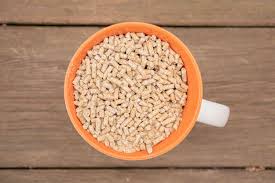There are two basic types of feeds:
The following are the types of animal feeds: (1) concentrates that have high energy value (including fats, cereal grains, oats and wheat), high-protein oil meals (soybean and canola), high-protein oil cakes (soybean and canola), and by-products from sugar beets, Sugarcane, animals and fish; and (2) roughages including straw, root crops, straw and cornstalks.
Concentrate foods
Cereal and their by-products
Barley, corn and oats are almost exclusively grown in North America and Northern Europe. However, small amounts are also processed for human consumption. These grains can be fed as a whole grain or ground with high-protein oil meal or other byproductsbyproducts, minerals and vitamins. This creates a complete feed for poultry and pigs. It also provides ruminants or horses with a dietary supplement.
Because of the seasonality of grain production, it is affected by temperature and moisture conditions. A full year of grain production is required during the short growing season. The grain must be dried to less than 14 percent moisture to prevent sprouting and molding. The grain should then be stored in containers or other buildings that are safe from rodents and insects. Because crop failures can sometimes happen, keeping more than one year’s worth of grains for use as feed is a good idea.
High-protein meals
Soybeans, peanuts (groundnuts), flaxseeds (linseed), cottonseeds, coconuts, and oil palm are a few of the vegetable seeds used primarily for oil production. These seeds can be processed to remove oil. The residues may contain between 5 percent and less than 1% of fat, 20 to 50 percent protein, and are sold as animal feeds. Peanuts and cottonseed have woody shells and hulls that are removed before processing. If the shells or hulls are not removed, the by-product will be higher in fiber, lower in protein, and less energy- and protein-rich. These meals are high in protein, but the quality varies depending on how many and readily available the amino acids are. Ruminants need only protein or nitrogen for the rumen microbes (synthesize amino acids).
These high-protein feeds are used to supplement low-quality roughages, and cereal grains and other low-protein foods to provide the necessary protein and amino acid for growth and production. It is important to consider the availability and cost of the supplement for your particular diet.
ByproductsByproducts of Sugar beets or Sugarcane
Beet tops are a product of the sugarbeet industry. They can be used fresh or ensiled on farms and dried beet pulp, beet molasses, and beet pulp, which can be produced in sugar factories. Cane molasses comes from the cane sugar manufacturing process. These are all high-quality, digestible carbohydrates. Sugarcane bagasse, also known as stalk residue, is fibrous and difficult to digest. It has a very low feed value. European beets are used as animal feed. Citrus Molasses and dried citric pulp are commonly used to provide high-quality feeds for cows or sheep.
Other by-product feeds
Many animal feeds are by-products of the commercial processing of cereal grain for human consumption. This is the largest category of by-product feeds. It includes wheat bran, wheat middlings and wheat germ meal. Some areas use bakery wastes such as leftover and stale loaves of bread and rolls to feed or filler for farm animals and pets. Rice bran and rice hulls can be obtained from mills that process rice for human consumption similarly. As by-products of starch production for industrial or food purposes, corn gluten feed, cornmeal, and hominy eat are made.
The brewer’s grains, corn distillers grains, solubles, brewer’s yeast, and other useful feeds are made from dried residues from fermentation industries that make beer and distilled spirits. The pineapple pulp, pineapple bran and the ensiled plants are all waste products of pineapple canneries. Meat and bonemeal are by-products of meatpacking plants and abattoirs. They also include meat and poultry waste, meat scraps, meat meals, and tankage. Fish-processing plants produce a variety of fish meals. These animal by-products usually contain 50% or more of high-quality protein and the minerals calcium (and phosphorus). These important minerals are particularly abundant in steamed bonemeal. The dairy industry produces feed by-products such as dried skin and dried whey.
Roughages
Pasture
The pasture grasses are the most important source of feed for ruminants, such as horses, cattle, sheep, and goats. They provide most of the feed needed for these animals during the growing seasons. Their cost is lower than feeds that must be harvested, processed and transported. Hundreds of grasses, legumes and trees can be used to feed grazing animals. Although the nutritional value of cultivated varieties has been researched, information is not complete for many naturally found.
Hay
When the grasses and legumes reach the peak of their growth, hay is made before the seed develops. This stage yields the highest digestible protein and carbohydrates per square meter of land. The moisture content is usually reduced to 18 percent to prevent mold, heating, and spoilage during storage. Legume hays such as alfalfa or clovers are rich in protein. However, grasses like Timothy or Sudan grass are lower in protein. Their maturity stage and the amount of nitrogen fertilization they have received will determine how different they are. When there isn’t enough pasture grass, animals can be fed hay stored in their yards.
Silage
Hay is made from immature plants being stored in an airtight container. This allows fermentation to produce acetic and lactic acids, which help preserve the most food. You can store silage in tower silos or in-ground trenches. Depending on the fodder, the forage must have a moisture content of between 50 percent and 70 percent. Low moisture levels may make it difficult to obtain sufficient packing to exclude air and lead to mold or other spoilage. Too high moisture levels can cause nutrient loss by seepage, which results in excessively acidic and unpalatable silage. Ensiled forage can last longer and lose fewer nutrients than dry hay. The type of fodder and the success of its cure will affect the nutritional value. Hay can be made from corn, sorghums and grasses, as well as leguminous forages.
Root crops
For economic reasons, root crops are less commonly used as animal feed today than in the past. Feed, beets, rutabagas (mangels), cassavas, turnips, and occasionally surplus potatoes are used. Root crops have a lower dry matter and protein content than other feeds. They mostly provide energy.
Straw hulls
After harvesting wheat, barley, oats and rice crops, straws are leftover and can feed cattle or other ruminants. Straws are very low in protein and high in fiber; their digestibility is poor. Straw can be useful for maintaining mature animals when other feeds are scarce. Still, it is not sufficient to provide adequate nutrition for long periods unless it is supplemented by other feeds that provide the necessary protein, digestible energy and minerals for growth and production. Alkali treatment of straw significantly increases its digestibility and cellulose, increasing its value as an energy source for animals.
In ruminant diets, corncobs, stalks and cottonseed hulls are all possible sources of fiber. The value of rice hulls is lower than the other types, but they are comparable to straw.






More Stories
Chocolate self saucing pudding
Chicken patties recipe
Can you eat a raw potato